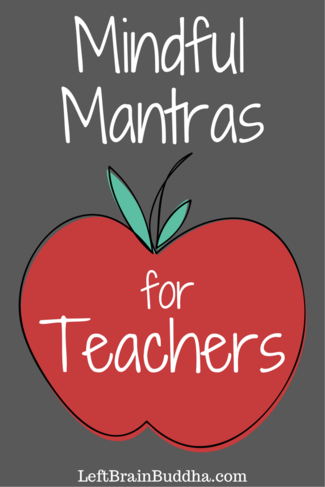
Some days in the classroom are magical -- we are energized, our students are excited, the lesson goes well, we laugh and have fun, students participate and learn and we leave for the day with a sense of accomplishment and purpose.
Other days are downright disastrous -- we are tired, students are distracted, the lesson bombs, we're annoyed and cranky, students challenge us, little is learned and we leave for the day wondering why the hell we ever chose this profession.
We've all been there, right?
I've learned that during tough moments in the classroom, I can call upon the inner stillness that is always with me, the stillness I cultivate through mindfulness practice. A simple way for teachers to bring mindfulness to the act of teaching is to recite a mantra -- a short phrase that helps us on those days when our classroom feels more like Lord of the Flies than Dead Poets Society.
Mindful Mantras for Teachers
1. Breathe
This is my number one, go-to mantra. Just one deep cycle of inhalation and exhalation activates our parasympathetic nervous system and invites a calming response in the body. And while a single breath is relatively short in duration, those eight seconds or so of quiet and calm that we model to our students can be incredibly powerful. Our mindful pause can facilitate our students' pauses. As teachers, we can be the stable nervous system in our classroom that students anchor to.
2. It's not personal
Teaching is an incredibly personal act. But it is powerful to be able to depersonalize our reactions to certain behaviors.
If I am in the middle of a, presumably, amazing and engaging lesson on the French Revolution, and there is a student who is obviously checked out and disengaged, I have a choice. I can take it personally, and construct a whole narrative about this student who hates my class and thinks my lesson stinks and clearly is lazy and is being so rude by not paying attention. Or I can realize it probably has nothing to do with me -- did he have a fight with his parents last night? Is he not sleeping well because of stress or illness? There are hundreds of possible reasons for his behavior, and they very likely are not about me.
If I can reframe how I see this student by not taking it personally, I am in a much better place to help him. Renowned educator Parker Palmer writes, "The way we diagnose our students' condition will determine the kind of remedy we offer." In teaching, as in medicine, misdiagnoses can be dangerous.
3. They're little kids in big bodies
One of my former colleagues said this all the time, and I think of her words frequently. Our students, especially in high school, may look all grown up, but they are still kids. Those big seniors? They were 12 just a few years ago. And those second graders? They were in diapers a few years ago.
We can certainly hold students to high, age-appropriate expectations. But it helps to remember that they haven't yet learned all the coping mechanisms we have for dealing with emotional crises and friendship drama and lunchroom politics. It helps to see the little kid underneath.
4. This is what it's like right now
A fundamental attitude of mindfulness is acceptance, or allowing. It's about befriending the present moment, whatever it may contain. We have a natural tendency to constantly judge our experience -- this is pleasant, this is unpleasant, this is neutral. And then we react based on that judgment, especially if we have decided it is something we don't like. We may hop on the Negative Train, which generally takes us through Why Is This Happening To Me?, briefly stops at Wow This Really Sucks, and usually ends at the final destination of It Will Always Be Like This.
What if, instead of getting on that train, we simply said, "This is what it's like right now"? Right now, teaching is hard. Right now, my classroom feels chaotic. Right now, I'm tired and I really don't want to grade these essays.
Accept and allow that that's what it's like right now.
In a few minutes, teaching may feel amazing, your students may inspire you, you may feel energized, and... well, you may not want to grade those essays, but you'll do it anyway, and with a better attitude.
The only thing we know for sure about teaching, and about life itself, is that it's always changing. The more we fight the present moment, the more we add to our suffering.
5. What can I control?
Acceptance of the present moment doesn't mean resignation. Some things are out of our control, like what our students had for breakfast or how much sleep they got last night. Those are the things that we must accept in the present, though we certainly can take skillful action in our communities to improve conditions for young people.
A beautiful aspect of teaching is how much we do control, like the atmosphere and expectations in our classroom, our lesson activities, and our relationships with students. If things aren't going well, acknowledge it, and take time to reflect. Is this something that is within my power to change? How might I do that? Reach out to your colleagues or other resources to discover ways to improve your craft.
And finally, a mantra for the awesome days:
6. "What gifts do I possess that helped make this moment possible?"
You know those days when you can just feel the energy and excitement in your classroom? The days that make you so glad you're a teacher? Those days don't just happen -- you play a major role in bringing them to fruition. Parker Palmer suggests we ask ourselves this question to become aware of our unique talents, so that we always teach from the core of our identity. Because that's when we make magic.
This post originally appeared on Sarah's blog Left Brain Buddha. You can follow Sarah on Facebook, Pinterest, and Google+.
